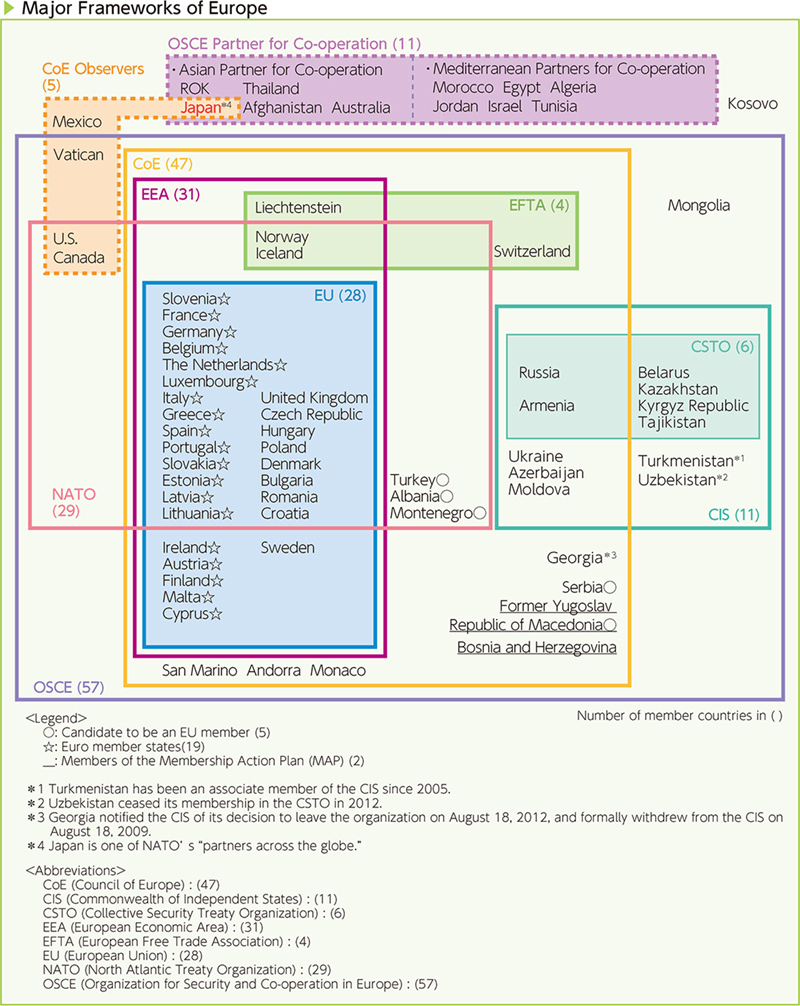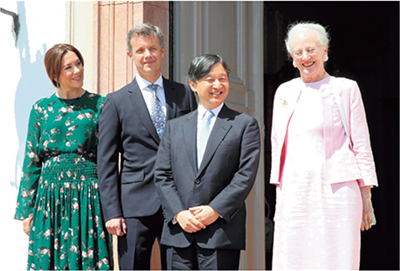Diplomatic Bluebook 2018
Chapter 2
Japan's Foreign Policy that Takes a Panoramic Perspective of the World Map
2 Collaboration with European Regional Institutions, and the Asia-Europe Meeting (ASEM)
(1)Cooperation with NATO
As a military alliance aimed at providing collective defense for its 29 member countries, NATO is currently conducting security-keeping operation in Kosovo, providing support in Afghanistan, helping counter-terrorism efforts, and engaging in crisis management, conflict prevention, and regional stabilization after conflicts both inside and outside of the region that could pose a direct threat to the security of the territories and peoples of NATO member countries. U.S. President Donald Trump had expressed the desire for NATO member countries to increase their defense burden sharing before his inauguration, and leaders at the meeting of NATO Heads of State and Government in May reaffirmed the target to spend 2% of its GDP on defense by 2024. Although great attention was paid to President Trump whether he would express the U.S.'s commitment to the Article 5 in the same meeting, such commitment was made public during his visit to Poland in July.
As a partner that shares fundamental values with NATO, Japan is taking specific steps towards collaboration based on the Individual Partnership and Cooperation Programme (IPCP), which Prime Minister Abe signed while visiting NATO headquarters in May 2014. During Japan-NATO high level consultations held in Tokyo in May, officials exchanged views on security policies in Japan and Europe. High-level talks continued throughout the year, with a visit to NATO headquarters in July by Prime Minister Abe followed by a visit to Japan by Secretary General of NATO Stoltenberg, who held talks with Abe and Foreign Minister Kono. During the Secretary General's visit to Japan, Japan and NATO issued a joint press statement calling for further efforts to apply decisive pressure on North Korea to urge North Korea to abandon its nuclear and ballistic missile programs, and the resolution of the abductions issue, as well as expressing concern for the situation in the South China Sea and East China Sea. Japan participated as an observer in NATO crisis management exercises (CMX), as well as training exercises related to cybersecurity and humanitarian assistance and disaster relief (HA/DR). Japan also dispatches female self-defense force official to NATO headquarters in order to promote cooperation on matters concerning women, peace and security.
In addition to financial contributions for development, Japan is also working with NATO to improve stability in Afghanistan. Japan provides support through Afghanistan National Army (ANA) Trust Fund for healthcare and education activities. Through the Partnership for Peace (PfP) Trust Fund, Japan is also providing support for clearing unexploded ordinance in Azerbaijan, removing unexploded ordnance and landmines and conducting explosive ordnance disposal training in Georgia, as well as supporting training women in the military in Jordan.
(2) Cooperation with the Organization for Security and Co-operation in Europe (OSCE)
OSCE is a regional security organization with 57 member countries across Europe, central Asia, and North America, that works to prevent conflicts and foster trust in these regions through a comprehensive approach. Japan has taken part in OSCE activities since 1992 as an Asian Partner for Co-operation. Japan provides support for preventing terrorism through means such as strengthening border patrol and conducting election monitoring in Afghanistan and central Asia including through the Border Management Staff College, and also lends support to the projects that support women's social advancement. OSCE plays an important role in improving the situation in Ukraine. Japan views the Ukrainian crisis as a challenge to the matter of the principle to maintain rules-based international order. Based on such view, Japan provides financial support to the OSCE Special Monitoring Mission (SMM) to Ukraine and has been dispatching experts to the SMM since August 2015. State Minister for Foreign Affairs Nakane attended Ministerial Council in Vienna, Austria, where he addressed “Free and Open Indo-Pacific Strategy,” the issues concerning North Korea's missile and nuclear programs, the situation in Ukraine, and measures to counter violent extremism. He called for the importance of thoroughly ensuring the rule of law and a concerted response from the entire international community.
(3) Cooperation with the Council of Europe (CoE)
CoE is a regional organization comprising 47 member states in Europe. It plays a key role in establishing international standards in areas concerning democracy, human rights, and the rule of law. As the CoE's sole observer country in Asia, Japan has made active contributions to a range of CoE activities since gaining membership in 1996. In 2017, Japan has provided financial support for a summer school to assist internally displaced persons (IDP) in Ukraine (Western Ukraine, August), the international forum in support of IDPs (Kiev, October), and roundtable talks discussing the establishment of international standards concerning NGOs and other organizations that receive extra-national funding (Venice, October).
(4) Cooperation through the Asia-Europe Meeting (ASEM)
ASEM was established in 1996 as the sole forum for dialogue and cooperation between Asia and Europe. It currently comprises 51 member states and two institutions, and works through Summits, Ministers' Meetings, seminars, and other activities focused on three main areas, namely (1) politics, (2) economy and (3) culture and society.
On November 20 and 21, ASEM held its 13th Foreign Ministers' Meeting in Nay Pyi Daw (Myanmar) whose themes are “Synergizing Peace and Sustainable Development” and “3rd Decade of ASEM: Making ASEM Partnership more Dynamic and Connected.”
In attendance from Japan was Parliamentary State Minister for Foreign Affairs Nakane, who provided an explanation of the “Free and Open Indo-Pacific Strategy,” a critical strategy in the interest of bringing Asia and Europe together, and emphasized the importance of making the Indo-Pacific region free and open. On issues concerning North Korea, State Minister for Foreign Affairs Nakane stated that now is the time for the international community as a whole to maximize pressure on North Korea and also asked each country for their understanding and support for the abductions issue. Concerning maritime security, he emphasized the importance of ensuring free and open maritime order in every region based on the rule of law. He also addressed the South China Sea problem by expressing his strong hopes for relieving tensions and progress towards demilitarization through settling effective Code of Conduct (COC) early in the South China Sea.
In the chairs' statement of the Foreign Ministers' Meeting, Foreign Ministers mentioned maritime security issues and condemned in the strongest terms the nuclear test and ballistic missile launches by North Korea. Ministers also explicitly referenced to the abductions issue, which was also referred to in the chairs' statements previously at the 10th G7 Summit in 2014, the 12th ASEM Foreign Ministers' Meeting in 2015, and the 11th G7 Summit in 2016.
In addition, Japan supports ASEM through contributions to the Asia-Europe Foundation (ASEF) and the tourism seminar (February) in Yangon co-hosted with the Government of Myanmar.
In addition, Deputy State Minister of Economy, Trade and Industry Kosaburo Nishime attended the 7th ASEM Ecomonic Ministers' Meeting conducted in Seoul, South Korea in September, the same month that State Minister of Land, Infrastructure, Transport and Tourism Takao Makino, attended the 4th ASEM Transport Ministers' Meeting held in Bali (Indonesia).

Japan and Denmark have built stable friendly relations traditionally in a variety of areas including politics, economy and culture, supported by the close relationship between the Imperial Family of Japan and the Royal Family of Denmark. The Imperial Family and Royal Family have had intimate exchanges over the years. While Their Majesties the Emperor and Empress paid a State Visit to Denmark in 1998, Her Majesty Queen Margrethe II and His Royal Highness the Prince Consort (Prince Henrik) paid a State Visit to Japan in 1981 and 2004, respectively.
Following the Great East Japan Earthquake in 2011, Her Majesty Queen Margrethe II donated to the disaster victims the proceeds from a charity auction where she auctioned off her craft works. She also raised relief donation from Danish businesses and donated it to the disaster-affected areas. His Royal Highness Crown Prince Frederick visited Higashimatsushima City, Miyagi Prefecture in June 2011, three months after the disaster. Such exchanges between Higashimatsushima City and the Royal Family of Denmark still continue today.
In 2017, both countries celebrated the 150th anniversary of the establishment of diplomatic relations. To hold commemoration events, His Imperial Highness the Crown Prince and His Royal Highness Crown Prince Frederick were appointed as the Honorary Presidents for this anniversary. His Imperial Highness paid an official visit to Denmark from June 15 to 21, 2017. This was his second visit to Denmark, following his first visit in 2004 to attend the wedding of His Royal Highness Crown Prince Frederick.
 His Imperial Highness the Crown Prince receiving a welcome to the luncheon at Fredensborg Palace by Her Majesty Queen Margrethe II and His Royal Highness Crown Prince Frederick and Her Royal Highness Crown Princess Mary (June 18, Denmark, Photo: The Asahi Shimbun)
His Imperial Highness the Crown Prince receiving a welcome to the luncheon at Fredensborg Palace by Her Majesty Queen Margrethe II and His Royal Highness Crown Prince Frederick and Her Royal Highness Crown Princess Mary (June 18, Denmark, Photo: The Asahi Shimbun)Upon arriving in Denmark on June 15, His Imperial Highness the Crown Prince received a warm welcome from His Royal Highness Crown Prince Frederick and Her Royal Highness Crown Princess Mary at Copenhagen's Kastrup Airport. On the next day, June 16, His Imperial Highness attended the “Japan in the Danish Royal House” exhibition which explored the long-standing mutual exchanges between the Imperial Family of Japan and the Royal Family of Denmark, together with His Royal Highness Crown Prince Frederick. In the evening of the day, His Imperial Highness attended a Japanese traditional music performance featuring the koto held as a part of the 150th anniversary celebration together with His Royal Highness Crown Prince Frederick and Her Royal Highness Crown Princess Mary.
On June 18, Her Majesty Queen Margrethe II hosted a welcome luncheon at Fredensborg Palace located on the outskirts of Copenhagen. On June 19, His Royal Highness Crown Prince Frederick and Her Royal Highness Crown Princess Mary hosted a dinner at Amalienborg Palace in Copenhagen.
His Imperial Highness visited “State of Green”, an institution that provides information about Danish policies and business initiatives on energy, water and environment, together with His Royal Highness Crown Prince Frederick to know measures on Danish environmental policies. His Imperial Highness also participated in a tour of the Port of Copenhagen with Her Royal Highness Crown Princess Mary.
His Imperial Highness also met with Prime Minister of Denmark Lars Løkke Rasmussen at the Prime Minister's Official Residence located outside of Copenhagen. Additionally, His Imperial Highness visited a variety of facilities which showcase Danish distinct features in the fields of the environment, design, marine shipping and welfare as well as these deeply connected to Japan. At each destination, His Imperial Highness had friendly exchanges not only with officials but with local residents, who extended a warm welcome. His Imperial Highness also met with Japanese nationals working for Japan-affiliated organizations and international institutions in Denmark as well as Danish people with a deep connection to Japan in such fields as culture, art, academia and business.
His Imperial Highness the Crown Prince's visit to Denmark reaffirmed the long-standing and wide-reaching cooperative relations between the two countries and served as a major event contributing to further development of friendly relations in the future.

